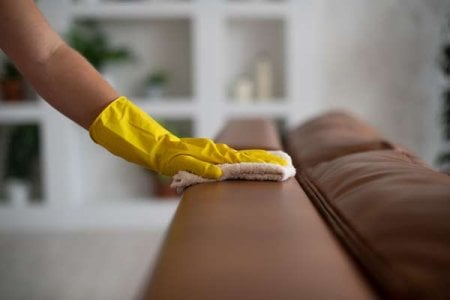Dirty sofas: Research shows Australians might be sitting ducks for germs!
- Replies 2
The humble sofa, a centrepiece of most Australian homes, is where we unwind after a long day, catch up on our favourite shows, and enjoy the company of family and pets.
It's no wonder that, according to new data from Temple & Webster, we spend an average of three hours a day lounging on our couches.
However, despite the significant role sofas play in our daily lives, it seems that many of us are neglecting an important aspect of sofa ownership: cleanliness.
The research, which emerged during Temple & Webster's hunt for a 'Chief Cushiness Officer', has revealed a startling truth: 44 per cent of those surveyed clean their sofa once a year or less.
Even more concerning, some participants admitted to not cleaning their sofas for more than three years, or never at all.
This lack of regular maintenance is surprising, given that sofas are a hotspot for germs, with approximately 19,200 germs per 100 square centimetres—that's more than the average toilet seat, according to a study by Unicef and Domestos.

Roger Wei, the Head of Design and Product Development at Temple & Webster, expressed his astonishment at the findings.
‘Perhaps they're time-poor, but I also think there needs to be more education around sofa maintenance. People need to know the differences between cleaning fabric and leather. Once you have this knowledge, you can then also apply this to the maintenance of other fabric and leather pieces around the home,’ he explained.
So, how often should you clean your sofas?
While daily or even weekly cleaning isn't necessary, Wei recommended tailoring your cleaning schedule to your lifestyle.
Households with children and pets, for example, may need to clean their sofas more frequently to address spills, stains, and pet hair.
According to Mr Wei, when it comes to cleaning, it's also important to consider the type of sofa you have.
‘Sofas that feature fixed back and seat cushions can be trickier in terms of accessing nooks and crannies. Of course, the more often you do the quick cleans, the deep cleans become less necessary,’ he said.
‘Deep cleaning can also be expensive so it's worth taking the trouble to do more frequent vacuums and spot cleans. The process for deep cleaning depends on the state of your sofa and the material.’
‘Make sure you do your research to avoid irreparable damage. Most people don't know the difference between PU faux leather and aniline dye full grain leather. The first can be cleaned easily with a wet cloth, while the second has to be cleaned with a proper leather cleaner, so make sure you do your research or consult a professional,’ he added.
In light of this, it's crucial to adopt effective cleaning routines to ensure the health and well-being of household members.
Discovering the importance of sofa cleanliness prompts a deeper exploration into expert-recommended cleaning techniques and routines, shedding light on simple yet often overlooked practices to maintain a healthy living environment.
 How often do you clean your sofa? What methods do you find most effective? Share your insights and recommendations in the comments below.
How often do you clean your sofa? What methods do you find most effective? Share your insights and recommendations in the comments below.
It's no wonder that, according to new data from Temple & Webster, we spend an average of three hours a day lounging on our couches.
However, despite the significant role sofas play in our daily lives, it seems that many of us are neglecting an important aspect of sofa ownership: cleanliness.
The research, which emerged during Temple & Webster's hunt for a 'Chief Cushiness Officer', has revealed a startling truth: 44 per cent of those surveyed clean their sofa once a year or less.
Even more concerning, some participants admitted to not cleaning their sofas for more than three years, or never at all.
This lack of regular maintenance is surprising, given that sofas are a hotspot for germs, with approximately 19,200 germs per 100 square centimetres—that's more than the average toilet seat, according to a study by Unicef and Domestos.

A recent survey found that 44 per cent of Australians clean their sofa once a year or less. Credits: Shutterstock
Roger Wei, the Head of Design and Product Development at Temple & Webster, expressed his astonishment at the findings.
‘Perhaps they're time-poor, but I also think there needs to be more education around sofa maintenance. People need to know the differences between cleaning fabric and leather. Once you have this knowledge, you can then also apply this to the maintenance of other fabric and leather pieces around the home,’ he explained.
So, how often should you clean your sofas?
While daily or even weekly cleaning isn't necessary, Wei recommended tailoring your cleaning schedule to your lifestyle.
Households with children and pets, for example, may need to clean their sofas more frequently to address spills, stains, and pet hair.
According to Mr Wei, when it comes to cleaning, it's also important to consider the type of sofa you have.
‘Sofas that feature fixed back and seat cushions can be trickier in terms of accessing nooks and crannies. Of course, the more often you do the quick cleans, the deep cleans become less necessary,’ he said.
‘Deep cleaning can also be expensive so it's worth taking the trouble to do more frequent vacuums and spot cleans. The process for deep cleaning depends on the state of your sofa and the material.’
‘Make sure you do your research to avoid irreparable damage. Most people don't know the difference between PU faux leather and aniline dye full grain leather. The first can be cleaned easily with a wet cloth, while the second has to be cleaned with a proper leather cleaner, so make sure you do your research or consult a professional,’ he added.
In light of this, it's crucial to adopt effective cleaning routines to ensure the health and well-being of household members.
Discovering the importance of sofa cleanliness prompts a deeper exploration into expert-recommended cleaning techniques and routines, shedding light on simple yet often overlooked practices to maintain a healthy living environment.
Key Takeaways
- According to a survey by Temple & Webster, 44 per cent of Australians clean their sofa once a year or less, with some not cleaning it for over three years, or never at all.
- Temple & Webster's research highlighted a lack of sofa maintenance awareness among consumers, with Head of Design Roger Wei suggesting more education is needed.
- According to a study by Unicef & Domestos, sofas can harbour more germs per square centimetre than the average toilet seat, emphasising the importance of regular cleaning.
- Mr Wei explained that the type of sofa and its material dictate the cleaning process, with different approaches for various materials like PU faux leather and aniline dye full grain leather.







